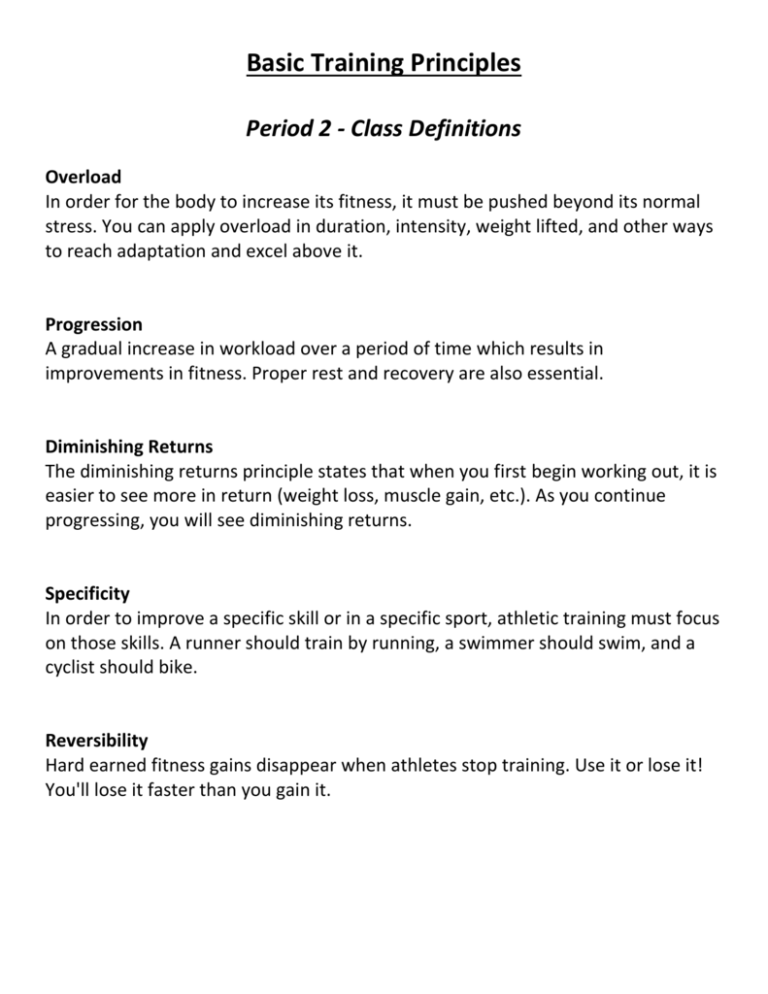Enumerate and Explain the Different Principles of Physical Fitness Training
In order to get the most out of your training you need to apply these key principles of training overload specificity reversibility and variation. The principles are S pecificity P rogression O verload R eversibility R est and T edium.

Principles Of Training Poster How To Plan An Effective Training Programme 4 Training Programs National Curriculum How To Plan
Physical fitness is a set of traits that allows an individual to perform physical activity.

. Principles of Physical Training. I thought I would take this opportunity to remind everyone to always consider the basic principles of training first and foremost when putting together your next training block. The more you do the more you will be capable of doing.
Regular exercise and physical activity increase muscle strength bone density flexibility and stability. This is how all the fitness improvements occur when exercising and training. Overload means we must put our bodies under more stress than normal in order for adaptive changes to be made.
3 Principles of physical fitness. Specificity relates to ensuring the training done is specific to the sport or activity. Aerobic activity or exercise causes you to breathe faster and more deeply which maximizes the amount of oxygen in your blood.
Improving performance is not about training more - competitors need to follow a carefully planned training programme. Your heart will beat faster which increases blood flow to your muscles and back to your lungs. The FITT principle is largely a practical amalgamation of all the other exercise principles.
To get the best out of your training you need to follow the set principles of training. Plateau Regression and Reversibility. Adaptation Rest and Recovery.
There is unanimous agreement in the fitness community that these are the five components of physical fitness though the definition of what level of fitness needs to be achieved is a personal on. The Four Principles Of Training Beginner Fitness In order to get the maximum out of your training you need to apply the four key principles of training specificity progression overload and individualisation to what you do. There are 6 Basic Principles of Physical Fitness.
Excessively long periods of recovery time can result in a detraining effect. This programme must be systematic and take into account the demands of the activity and the needs preferences and abilities of the performer. The Principle of Reversibility refers to the loss of fitness that results after you stop training.
The Overload Principle can be achieved through changes in Frequency Intensity. Overload specificity and progression. The human body is an amazing machine.
Discover why the principles of training are important and how to apply each one to a fitness regimen. Physical fitness can reduce your risk for and resilience to accidental injuries especially as you get older. The biological principle of.
By using the principles of training as a framework we can plan a personal training programme that uses scientific principles to improve performance skill game ability and physical fitness. Physical activity refers to the contraction of skeletal muscle that produces bodily movement and requires energy. Principles of Physical Activity 1.
These principles combine up to one acronym ie SPORRT. The better your aerobic fitness the more efficiently your heart lungs and blood vessels transport oxygen throughout your body and the easier it. The principles of physical training are.
These principles are the principle of overload the principle of progression the principle of specificity the principle of recovery the principle of individuality and the principle of reversibility. The Overload Principle means that the body will adapt to the demands placed upon it. For any adaptation to take place the human body is required to exert itself beyond the normal stress levels of training.
Whatever level of fitness you are at there are some common principles to remember to improve yourself and achieve your goals. Reduce your risk of injury. In order to get the most out of your training you must follow some basic simple training principles which are overload specificity reversibility and variance.
In time you will revert back to your pre-training condition. Each of the fitness components has an ideal training frequency how often intensity how hard time duration rest intervals and type of exercise to be used. Exercise is a physical activity that is planned and is performed with the goal of attaining or maintaining physical fitness.
THE PRINCIPLES OF PHYSICAL ACTIVITY 2. There are three main principles of fitness training. See answer 1 Best Answer.
The best training programs are based on set principles. The five components of physical fitness are cardiovascular endurance muscular strength muscular endurance flexibility and body composition according to Fit Day. Overload In order to progress and improve our fitness we have to put our bodies under additional stress.
For example stronger muscles and better balance mean that youre less likely to slip and fall and.

The Principles Of Training Supercharge Your Fitness Castore

Principles Of Training Physical Education School Posters Physical Education Lessons Health And Physical Education Physical Education


Belum ada Komentar untuk "Enumerate and Explain the Different Principles of Physical Fitness Training"
Posting Komentar